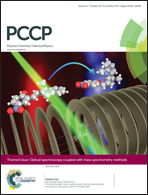The electronic and optical properties of MoS2(1−x)Se2x and MoS2(1−x)Te2x monolayers
Abstract
In a very recent article, atomically thin two-dimensional MoS2xSe2(1−x) nanosheets have been synthesized with complete composition tunability using a temperature gradient assisted chemical vapor deposition technique [J. Am. Chem. Soc., 2014, 136, 3756]. To have a better understanding of the composition dependent tunability of the properties of this class of materials we here perform first principles calculations on the detailed electronic structure of single layered transition metal dichalcogenides MoS2(1−x)Se2x and MoS2(1−x)Te2x. The positive value of mixing energy of both MoS2(1−x)Se2x and MoS2(1−x)Te2x 2D sheets at various composition confirms their formation at some energy cost. The analysis of the composition dependent band structure and the density of states of these 2D sheets reveals certain interesting features. The band gap variation of the MoS2(1−x)Se2x nanosheets is almost linear with composition while that of MoS2(1−x)Te2x deviates slightly from linearity. We have also calculated the optical absorption spectrum of these nanosheets as a function of composition and found that the optical transitions are mainly metal d–d type spin forbidden transitions.


 Please wait while we load your content...
Please wait while we load your content...